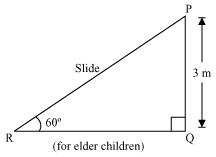Ask questions which are clear, concise and easy to understand.
Ask QuestionPosted by Nerajaa A.V 4 years, 1 month ago
- 1 answers
Posted by Divyansh Kumar 4 years, 1 month ago
- 2 answers
Khushi Kulshrestha 4 years, 1 month ago
Khushi Kulshrestha 4 years, 1 month ago
Posted by Arshdeep Kataria 4 years, 1 month ago
- 3 answers
Kaviya Sudhan 4 years, 1 month ago
Posted by The -Bandits 4 years, 1 month ago
- 1 answers
Sia ? 4 years, 1 month ago
1.A cut out of a geometrical figure such as a triangle is made and placed on a rectangular sheet of paper marked with X and Y-axis.
2.The co-ordinates of the vertices of the triangle and its centroid are noted.
3.The triangular cut out is displaced(along x-axis, along y-axis or along any other direction.)
4.The new co-ordinates of the vertices and the centroid are noted again.
5.The procedure is repeated, this time by rotating the triangle as well as displacing it. The new co-ordinate of vertices and centroid are noted again. Displacement and rotation of a geometrical figure.
6.Using the distance formula, distance between the vertices of the triangle are obtained for the triangle in original position and in various displaced and noted positions.
7.Using the new coordinates of the vertices and the centroids, students will obtain the ratio in which the centroid divides the medians for various displaced and rotated positions of the triangles.
Posted by Dev Singh 4 years, 1 month ago
- 1 answers
Posted by Arsh Deep Kaur 4 years, 1 month ago
- 1 answers
Posted by Gurubasavaraj Angadi 4 years, 1 month ago
- 0 answers
Posted by Sameer Sharma 4 years, 1 month ago
- 1 answers
Divyanshi Saxena 4 years, 1 month ago
Posted by Towfic Islam 4 years, 1 month ago
- 2 answers
Posted by Prashanth .N 4 years, 1 month ago
- 1 answers
Posted by Dhanraj Pandey 4 years, 1 month ago
- 1 answers
Sumit Yadav 4 years, 1 month ago
Posted by Sankar Sss 4 years, 1 month ago
- 1 answers
Sumit Yadav 4 years, 1 month ago
Posted by Kanchan Kumawat 4 years, 1 month ago
- 2 answers
Chahak Nashine 4 years, 1 month ago
Posted by Manish Kumar 4 years, 1 month ago
- 1 answers
Sia ? 4 years, 1 month ago
Let the given number when divided by 143 give q as quotient and 31 as remainder. Then, number = 143q + 31 { 13×11q+13×2+5)=13×(11q+2)+5
So , the same number when divided by 13 gives 5 as remiander.
Posted by Ankit Kumar 4 years, 1 month ago
- 1 answers
Posted by Shobhit Baghel 4 years, 1 month ago
- 3 answers
Posted by Nishita Shah 4 years, 1 month ago
- 4 answers
Harshika Yadav 4 years, 1 month ago
Anmol B 4 years, 1 month ago
Posted by Taniya Dandriyal 4 years, 1 month ago
- 1 answers
Sia ? 4 years ago
In the first case:

Height of slide= 1.5 m and angle of elevation = 30°
Now,
{tex}\sin \theta=\frac{p}{h}{/tex}
where p = perpendicular, i.e. height of the slide and h = hypotenuse, i.e. length of the slide and {tex}\theta{/tex} is the angle of elevation
{tex}\sin 30^{\circ}=\frac{1.5}{h}{/tex}
{tex}\frac{1}{2}=\frac{1.5}{h}{/tex}
Hence, h = 3 m
In the second case:

Height of slide, = 3 m, angle of elevation = 60°
{tex}\sin \theta=\frac{p}{h}{/tex}
{tex}\sin 60^{\circ}=\frac{3}{h}{/tex}
{tex}\frac{\sqrt{3}}{2}=\frac{3}{h}{/tex}
Hence, h = {tex}2{\sqrt{3}}{/tex} m
Therefore, the length of the slide in the first and the second case are 3 m and {tex}2{\sqrt{3}}{/tex} m respectively.
Posted by Ansh Tyagi 4 years, 1 month ago
- 1 answers
Posted by Simran Jaiswal 4 years, 1 month ago
- 2 answers
Sia ? 4 years, 1 month ago
A consistent system of equations has at least one solution, and an inconsistent system has no solution.
Saksham Mishra 4 years, 1 month ago
Posted by Sreeram S Nair 4 years, 1 month ago
- 1 answers
Posted by Sonu Kumar 4 years, 1 month ago
- 1 answers

myCBSEguide
Trusted by 1 Crore+ Students

Test Generator
Create papers online. It's FREE.

CUET Mock Tests
75,000+ questions to practice only on myCBSEguide app
 myCBSEguide
myCBSEguide